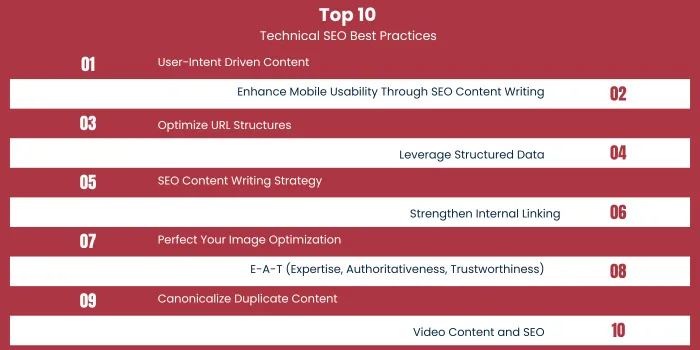

Studies show that 40% of users don't check sites that take more than 3 to 4 seconds to load. The modern internet user is impatient, expecting fast-loading websites, seamless navigation, and mobile-friendly experiences. At the same time, search engines like Google continually update their algorithms to prioritize user experience, security, and content relevance.
Therefore, mastering technical SEO is essential to gaining a competitive edge in search engine rankings. Prerender reports that SEO-friendly websites are 62% more likely to see better rankings; hence, optimizing your website for user experience and search engine algorithms has never been more crucial.
Addressing these technical requirements is critical for search engine optimization sites to thrive. A well-optimized website ensures efficient indexing, better crawlability, and improved user satisfaction, leading to higher search rankings and increased organic traffic. Through this blog, you will learn 10 strategies to boost your rankings and prepare for future SEO content writing trends.
Let’s dive in!
As search engines develop and user expectations change, staying up-to-date with the latest technical SEO content writing trends is essential. In 2025, these emerging trends will shape how search engines evaluate and rank search engine optimization sites, making it essential to adapt your strategies accordingly.
Core Web Vitals are Google’s essential metrics for measuring page experience, and they have become crucial for ranking success. These metrics focus on the following:
💡 Protip: To provide a better user experience, keep your LCP under 2.5 seconds, FID below 100ms, and CLS under 0.1. These benchmarks are critical for securing top rankings. Use tools like Google PageSpeed Insights or Lighthouse to diagnose performance issues and optimize your site accordingly.
AI tools like ChatGPT, Jasper, and Surfer SEO are revolutionizing how SEO content writing professionals create optimized content. These platforms help marketers analyze user intent, identify relevant search trends, and generate content that aligns with technical SEO best practices.
AI’s ability to process large amounts of data allows for better keyword research, on-page optimization, and efficient content planning.
✅ Action Step: Use AI to optimize your content by generating schema markup, analyzing keywords for intent, and enhancing the overall content quality to match search engine requirements.
Recent trends indicate that AI-generated content is quickly becoming a game-changer. According to Content Marketing Institute, AI can improve content production efficiency by 50-60%.
|
Read: How LexiConn Helped Amazon Increase Web Traffic with SEO Blogs |
According to research by eMarketer, 162.7 million US households are expected to use voice assistants by 2027; focusing on voice search is essential for aligning with the needs of voice-first users.
The increasing use of voice assistants, such as Amazon’s Alexa, Google Assistant, and Apple’s Siri, has led to a rise in voice searches. Users are now asking more conversational, long-tail queries like, “What are the best SEO practices for 2025?” Optimizing for voice search is vital for staying competitive in search rankings.
📱 Protip: To optimize for voice search, integrate natural language phrases and question-based keywords into your content. Focus on long-tail keyword phrases that people naturally use when speaking.
Zero-click searches refer to search results that provide an answer instantly on the search engine results page (SERP), such as featured snippets, People Also Ask boxes, and local packs. Optimizing for zero-click searches is more important as these results grow.
Recent data by Sparktoro reveals that more than 50% of all searches now result in zero-click answers, highlighting the importance of appearing in these featured snippets for greater visibility and traffic
To stay competitive in the ever-changing world of SEO, implementing up-to-date technical SEO best practices is essential. The following practices are crucial for improving your website’s ranking and user experience. These strategies will help you adapt to changes in 2024 and prepare for the evolving landscape in 2025.

User intent is crucial for crafting content that echoes with your audience and ranks well on search engines. Understanding whether users are looking for informative, transactional, or navigational content can significantly improve the relevance of your pages.
🔍 How to Optimize for User Intent?
✅ Action Tip: Create dedicated landing pages for specific user intents to guide visitors directly to the information or product they seek.
|
Read: How BPCL Engaged with Lexiconn to Curate Content for 500+ Travel Destinations |
More than 50% of web traffic arrives from mobile devices, so it's crucial for SEO content writing to cater to mobile users. Content should be easily available and readable on smaller screens, and technical SEO considerations, such as page load speed, should be prioritized to reduce bounce rates.
📱 How to Improve Mobile Experience?
✅ Action Tip: Regularly check how your content looks on different mobile devices and make adjustments to ensure a smooth user experience.
URLs are more than just web addresses—they’re also a ranking factor that impacts SEO and user experience. Clean, concise, and descriptive URLs are easy to understand and help search engines index content efficiently.
🔑 Best Practices for URLs:
✅ Remember: Replace underscores (_) with hyphens (-) for better readability.
Tip: Use short and keyword-rich URLs to improve crawlability and click-through rates.
Structured data assists search engines in verifying the context of your content and improves visibility in search results. By implementing schema markup, you can improve the likelihood of appearing in rich snippets, which are increasingly important in SERPs.
Examples of Structured Data:
✅ Action Step: Use Google’s Rich Results Test to verify structured data implementation.
An SEO content writing-first approach prioritizes high-quality, user-focused content before technical tweaks. This trend is crucial as search engines like Google have become more sophisticated at evaluating content quality based on user intent and engagement. Content that answers specific user queries effectively is more likely to rank higher.
📝 Best Practices for Content Optimization:
✅ Action Tip: Optimize your content for featured snippets by structuring it to answer common questions directly.
Internal linking helps create a logical structure for your site, making navigating easier for users and search engines. Proper internal linking distributes link equity and enhances the visibility of deeper pages.
🔗 Best Practices:
Tip: Internal links help search engines discover and index new content faster.
Images are essential for user engagement but can negatively impact site speed if not optimized properly. Optimizing images for SEO improves load times and enhances overall site performance.
Steps to Optimize Images:
✅ Protip: Alt text isn’t just for SEO—it’s vital for accessibility and helps visually impaired users navigate your site.
Google’s Quality Rater Guidelines emphasize E-A-T, which means content needs to demonstrate expertise, authority, and trustworthiness. Websites with high E-A-T are more likely to rank higher, especially in competitive niches like health, finance, and legal industries.
📜 How to Improve E-A-T:
✅ Action Tip: Regularly update your content and ensure all information is accurate and verifiable. This will help you build trust with both users and search engines.
Duplicate content can confuse search engines and negatively impact rankings. Using canonical tags to identify the preferred version of a webpage helps search engines understand which URL to index.
📑 How to Use Canonical Tags:
✅Action Step: Resolve duplicate content issues by implementing canonical tags across your website.
Video content continues to be a predominant force in SEO. Optimizing videos can enhance user engagement and lead to higher rankings in search results. Google increasingly uses video content to provide answers in search results, and YouTube (the second-largest search engine) can also drive traffic to your website.
🎥 Best Practices for Video SEO:
✅ Action Tip: Optimize video content for mobile devices, as a significant portion of smartphone video consumption occurs.
SEO success isn’t just about rankings—it’s about achieving business objectives through increased visibility, engagement, and conversions. To measure your success accurately, focus on the following key performance indicators (KPIs):
🔗 Recent Data Point: Websites with strong SEO efforts achieve an average CTR of 3-5% on search results
Technical SEO in 2024 and 2025 is about more than just meeting Google’s guidelines; it’s about providing a superior user experience. By implementing the practices outlined here, you’ll future-proof your website and remain ahead in the competitive landscape.
Looking to improve your website’s technical SEO with best practices? At Lexiconn, we specialize in optimizing content to boost your SEO performance. Reach out to us at www.lexiconn.in or contact us via email at [email protected]. Additionally, Lexiconn offers a free 30-minute content consultation session to assist with your content strategy.



I have read and accept the Privacy Policy
Read More